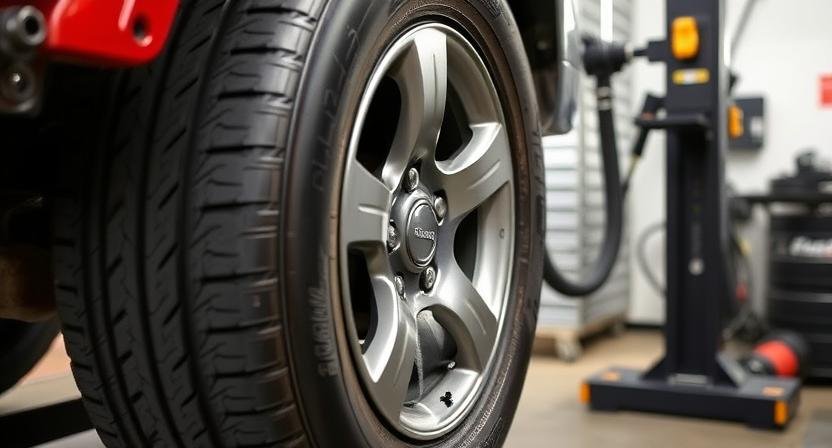
Picture this: you walk into a tire shop thinking you need one new tire. The mechanic looks at your car and says, “Actually, you need to replace all four tires.” Your jaw drops. How did this happen? You skipped tire rotation, and now you’re facing a massive expense that could have been avoided.
This scenario plays out constantly across the country. People either don’t rotate their tires at all, or they do it incorrectly. Either way, it turns routine maintenance into a major expense that hits your wallet hard.
Why Tires Wear Unevenly (It’s Not Random)
Your car is constantly fighting physics, and your tires take the beating. Think about it: your front tires do the steering AND most of the braking. Your rear tires mainly just roll along for the ride (unless you’re accelerating hard).
This means your front tires work significantly harder than your rear ones. Add in the fact that most cars are heavier in the front due to engine placement, and you’ve got a recipe for uneven wear patterns that can be dramatic.
Without rotation, your front tires can wear out at nearly twice the rate of your rear ones. Mechanics regularly see vehicles where the front tires are completely worn while the rears still have substantial tread remaining. That’s not just wasteful – it creates serious safety concerns.
The Magic Number: Every 6,000 Miles
Most experts say rotate every 5,000-7,500 miles, but 6,000 miles is the sweet spot for most people. Here’s why: it usually lines up with every other oil change, so it’s easy to remember.
But this isn’t a one-size-fits-all thing. If you drive like you’re in Fast & Furious, tow heavy stuff, or sit in stop-and-go traffic all day, you might need to rotate more often – like every 3,000-5,000 miles.
If you mostly drive on highways at steady speeds, you might be able to stretch it to 8,000 miles. But you have to actually pay attention to how your tires are wearing to know for sure.
The Right Way to Rotate (Most People Get This Wrong)
There are different patterns for different types of cars, and using the wrong one is like doing the job halfway.
Front-wheel drive cars: Move the front tires straight back, and move the rear tires to the opposite front positions (so rear left goes to front right, rear right goes to front left).
Rear-wheel drive cars: Move the rear tires straight forward, and cross the front tires to the back.
All-wheel drive cars: Usually just move front to back on the same side, but check your manual because some AWD systems are picky.
Directional tires: These can only roll in one direction (there’s usually an arrow on the sidewall). You can only move them front to back on the same side.
Things That Mess Up Your Rotation Schedule
Your wheels might be perfectly aligned when you buy your car, but over time, things get knocked out of whack. Hitting potholes, curbs, or just normal wear can throw off your alignment. When this happens, your tires wear unevenly no matter how often you rotate them.
If you rotate your tires and they still wear weird, get your alignment checked. It might cost $100, but it’ll save you way more in tire costs.
Tire pressure also matters here. If you’re rotating tires that are always low on air, you’re just spreading the problem around instead of fixing it.
DIY vs. Professional: What You Need to Know
Rotating tires looks simple, but there are ways to mess it up. If you want to do it yourself, you need:
- A good jack and jack stands (never trust just a jack)
- A torque wrench to tighten the lug nuts properly
- Knowledge of your car’s specific requirements
Over-tightening lug nuts can warp your brake rotors. Under-tightening them… well, that’s obviously bad news.
Pros have the right equipment and can spot problems you might miss, like alignment issues or worn suspension parts. They also deal with TPMS sensors, which can be tricky.
Modern Car Problems
Newer cars have tire pressure monitoring systems (TPMS) that track which sensor is where. After rotation, some cars need to be reprogrammed to know where each sensor moved to.
Some cars have different size tires front and back, which means you can’t rotate them at all. Others have directional wheels or special requirements.
Always check your owner’s manual before rotating. Some car warranties actually require documented tire rotations to stay valid.
The Math That’ll Convince You
Let’s break down the money:
- Professional rotation: $50
- How often: 6 times during the life of your tires
- Total cost: $300
Compare that to:
- Replacing tires early because you didn’t rotate: $800-1,500 extra
- Yeah, it’s a no-brainer.
Plus, proper rotation can add 20,000-30,000 miles to your tire life. That’s like getting an extra year or two out of your tires.
Keep Track of Everything
Start a simple log: when you rotated, the mileage, and any weird wear patterns you notice. Most tire warranties require proof of rotation to honor claims, so keeping records can literally pay off.
Take photos of your tires occasionally. It helps you spot problems early and gives you evidence if you need to make a warranty claim.
The Bottom Line
Tire rotation is like flossing your teeth – it’s boring, but if you skip it, you’ll pay later. The difference is that skipping tire rotation can cost you thousands of dollars instead of just a lecture from your dentist.
Your tires are expensive, and they’re literally what keeps you connected to the road. Treat them right, and they’ll last longer and keep you safer.
Set a reminder on your phone. Write it on your calendar. Do whatever it takes to remember, because a $50 rotation beats a $2,000 tire replacement every single time.